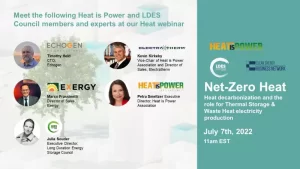[vc_row][vc_column][vc_column_text]The DOE estimates there are fifteen gigawatts of waste heat to power capacity in the US. Given equal tax treatment to renewable energy sources, industrial waste heat could provide enough emission-free electricity to power approximately 15 million American homes, provide hundreds of thousands of new American jobs, and support critical US manufacturing industries. WHP is a non-polluting energy source that will add to our nation’s energy security. However, because the technology is relatively new, it should be treated like other renewables when they were new to the market and receive the same incentives including ITC, PTC, and low interest loans. As demand for electricity continues to increase and our ability to meet that demand becomes more challenging, US legislators should support the deployment of emission-free waste heat to power. Loy Sneary, President/CEO Gulf Coast Green Energy, headquartered in Bay City, TX with WHP projects in MS, TX and Cyprus
Turning waste heat to power would cut pollution and make industry more competitive, yet it is the only clean energy technology that the government does not encourage through tax incentives, putting it at a disadvantage in the marketplace. It’s about time WHP is given a fair chance to compete. John Prunkl, CEO, Ironclad Energy Partners, headquartered in Westmont, IL with CHP projects in NY, NJ, MA and CA
According to the DOE, waste heat is the largest opportunity for industrial energy efficiency in the United States, and is worth $6B per year. Identifying WHP for the Investment Tax Credit will help U.S. industry increase efficiency, reduce emissions, and save money while at the same time increasing adoption rates of WHP technologies, creating more US manufacturing jobs. Waste heat is an important, fuel-free, emission-free, clean energy source that deserves the same incentives as renewable sources. Michael F. Newell, CEO, Ener-G Rotors, Inc., headquartered in Rotterdam, NY
We own and operate one of the largest waste heat to power projects in the U.S. for the benefit of a large steel producer in the Midwest. The economic and environmental benefits of this project are undeniable and have helped position our customer as a low cost producer of steel in the region while helping them produce their product with a smaller environmental impact. Including WHP in the ITC would lower the cost of capital so many more companies could benefit from waste heat to power projects at their plant sites which would in turn support jobs and the local economy. Mo Klefeker, President & CEO, Primary Energy, headquartered in Oak Brook, IL with WHP and CHP projects in IN
For the US to take advantage of this enormous resource to increase fuel-free emission-free power, WHP needs to be treated equal to the other renewable technologies. This will increase adoption rates, accelerate projects, and create US manufacturing jobs for projects here and for exports across the globe. John Fox CEO, ElectraTherm, headquartered in Reno, NV with WHP, geothermal, solar thermal and biogas projects in LA, MI, NV, SC and Europe
Federal agencies claim WHP falls under the umbrella of CHP, yet WHP does not qualify under the 10% investment tax credit (ITC) that CHP receives. WHP needs to be clearly qualified in ITC language in order to give this energy source equal footing with CHP solutions, or, better yet, WHP needs to be qualified as a renewable resource to receive the 30% ITC that renewables receive. This change will go far to support the growth of this largely untapped and highly economical solution. Phil Brennan, CEO, Echogen Power Systems, headquartered in Akron, OH with WHP projects on marine vessels
Integral Power is on the front lines developing waste heat to power across a wide spectrum of industries including coke calcining, steel and cement manufacturing, and waste incineration. These project opportunities represent hundreds of megawatts of power generation while producing zero incremental emissions, adding new skilled jobs and making the host plants more competitive in their industries. The challenge that we face is that these projects are expensive to implement, with total installed costs typically in the range of $2,000-4,000/KW. An Investment Tax Credit is imperative to help these projects achieve an acceptable rate of return which would allow many projects to move forward that are currently on the shelf, representing deployment of hundreds of millions in capital. Ray Deyoe, Managing Director, Integral Power, LLC, headquartered in Houston, TX with a WHP project in TX
[/vc_column_text][vc_single_image image=”25204″ img_size=”full” alignment=”center” onclick=”link_image”][/vc_column][/vc_row]





